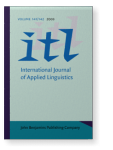Vol. 141/142 (2003) ► pp.199–223
Vol. 141/142 (2003) ► pp.199–223
Improving EFL learners' pragmatic awareness
why and how
This paper overviews the ways in which EFL learners' pragmatic awareness can be developed in language classrooms through focused instruction and practice. It argues that effective communication requires awareness of the conventions governing language use and attention to the characteristics of the context and the interlocutors, besides linguistic resources. The main claim is that even though some pragmatics data that is based on native speaker norms might not provide relevant models for learners of English as a foreign or international language, these learners still need to become aware of crosscultural variation in norms of language use and learn how to consider social and contextual factors surrounding effective communication. After defining pragmatic competence and transfer, the paper discusses possible ways for integrating pragmatic consciousness-raising into language teaching and the problems involved in this endeavour. It then describes a course designed to raise pragmatic awareness in advanced level EFL learners as part of their TEFL training program. The underlying principles, materials and sample activities of the course are presented and learners' reaction to the course is discussed.
